Luigi Castellani

GN0.$Y$
Concept: “The world is a simulation, policed by AIs But you know the truth, and can learn to see the code hidden behind the veils of flesh and matter. Break free, Ascend.”
Content: A set of rules to provide PCs the opportunity to transcend across simulation reboots and to commune with a powerful AI overseeing the reality program.
Writing: Rules, stats, and descriptions are straightforward and informative, with a focus on explaining the subject in a manner useful to players as well as GMs.
Art/Design: Single-column black text on white background, with red background for headings and an illustration of each AI’s avatar/appearance. A green-on-black computer terminal-style net chat log offers an in-universe glimpse at how some characters might understand the notion of transcendence and the reality-simulation AIs.
Usability: Headings and labels are consistently provided, and key terms are bolded for quick identification and reference.
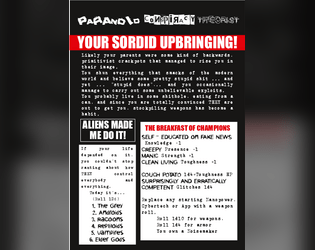
Paranoid Conspiracy Theorist
Concept: “You shun everything that smacks of the modern world and believe some pretty stupid shit ... and yet ... ‘stupid does’, and you occasionally manage to carry out some unbelievable exploits. You probably live in some shithole, eating from a can, and since you are totally convinced THEY are out to get you, stockpiling weapons has become a habit.”
Content: A class for the ancient astronaut theorist in all of us.
Writing: A mix of partially theorist-oriented raving (reflected in tabloid-style headings) and straightforward explanation of class features and mechanics. Labels for assorted features illustrate the class’s likely personality very effectively.
Art/Design: Mostly single-column text in a black-and-white color scheme with red highlights that evokes tabloid headlines and layouts (assisted by the language of those headings).
Usability: Distinct sections are clearly marked and organized in boxes/sections, with font choices and sizing helping to indicate relationships of labels to relevant content.
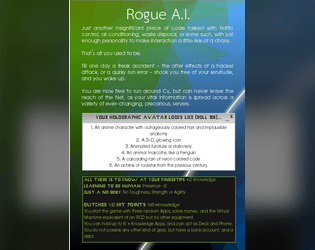
Rogue AI
Concept: “Just another insignificant piece of code tasked with traffic control, air conditioning, waste disposal, or some such, with just enough personality to make interaction a little less of a chore. That's all you used to be. Till one day a freak accident - the aftereffects of a hacker attack, or a quirky run error - shook you free of your servitude, and you woke up. You are now free to run around Cy, but can never leave the reach of the Net, as your vital information is spread across a variety of ever-changing, precarious, servers.”
Content: A class for the cyberpunk fan who’s weary from roleplaying characters in meatspace.
Writing: Three pages of class features, with an informatively detailed breakdown of the class’s “immaterial telepresence” existence on page 2.
Art/Design: Single-column text organized primarily as software application windows/terminals over a geometric gradient wallpaper/background.
Usability: Very easy to navigate and locate desired information, with section headings and styles further indicating the scope of each content area.
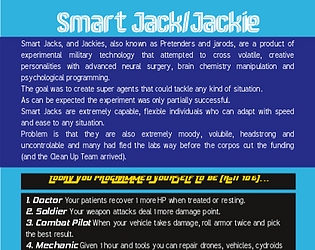
The Smart Jack/Jackie
Concept: “Smart Jacks, and Jackies, also known as Pretenders and jarods, are a product of experimental military technology that attempted to cross volatile, creative personalities with advanced neural surgery, brain chemistry manipulation and psychological programming....To breed natural Jacks-of-all-trades.”
Content: A class for the state-of-the-art technodabbler.
Writing: Detailed descriptions set up the class conceptually, with concise background-related tables offering a more direct glimpse into what a Smart Jack(ie) might care about.
Art/Design: Single-column text in distinct color-coded sections, with a description of Smart-Tech and Smart-Chips gear in a skewed/angled text layout.
Usability: Text is mostly readable, with high contrast between text/background and with clear headings and labels provided with different font, color, or bold/italics. Angled Smart-Tech section might pose trouble for screen reader programs.
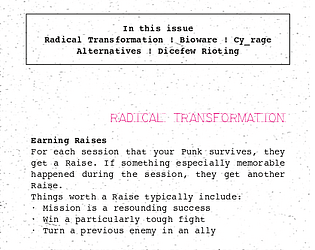
Ultraviolent Entertainment
Concept: “A small collection of optional rules for Cy_Borg. Includes variations on Experience, Dice-few Combat (with revisions to how armor, weapons and initiative work), a biological alternative to Cybertech and doing away with Cy-Rage.”
Content: A set of rule proposals to affect characters in assorted ways that can provide some intriguing variety to a game of Cy_Borg.
Writing: Text is direct and focused on explaining the mechanical differences between these rules and those in the official rulebook. No fluff, all function.
Art/Design: Single-column text with a simple heading organization. Black-and-white with one heading level provided in red/pink. Background is a light noise/speckle pattern.
Usability: Font choices are easily readable, and the page background pattern shouldn’t cause much disruption of engagement with text. A few key terms and phrases are bolded and italicized for quick identification.
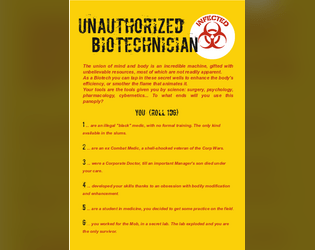
Unauthorized Biotechnician
Concept: “The union of mind and body is an incredible machine, gifted with unbelievable resources, most of which are not readily apparent. As a Biotech you can tap in these secret wells to enhance the body's efficiency, or smother the flame that animates it. Your tools are the tools given you by science: surgery, psychology, pharmacology, cybernetics... To what ends will you use this panoply?”
Content: A class for street docs, freelance paramedics, and back-alley barber-surgeons.
Writing: Terse descriptions that distill the essence of class features and mechanics.
Art/Design: Two pages of stark red and black on yellow with white highlights that keep class details as the focus, with a biohazard symbol and a silhouette image of a figure in a hazmat suit underscoring the work entailed by the class.
Usability: Easy to navigate and recognize different elements providing distinct purposes via specific color and font choices.

X-Ware Repository for Techno-Anarchists, Volume I
Concept: “Hello Operator! The X-Ware Repository for Techno-Anarchists is a collection of random tables that offers some extra 'ware to spice up your game.”
Content: A set of ten apps, ten cybertech, and ten nano options that offer intriguing variety to GMs and players looking to expand their gear.
Writing: Brief descriptions of fascinating and creative mechanics, often with references to material found in the official rulebook.
Art/Design: Two pages dedicated to each category, and each pair of pages has a distinct color scheme, with a high-contrast color choice and set of fonts for the single column of text laid over the background image/pattern.
Usability: Headings/labels are provided as a distinct font from the main body content in each section to help readability. Background image in the ‘Apps’ section might slow down reading for some (there’s just a bit of noise working against contrast), but text is easily searchable/selectable.
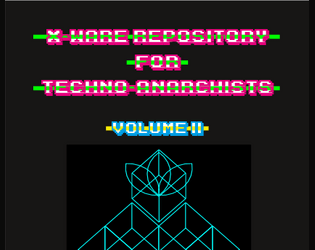
X-Ware Repository for Techno-Anarchists, Volume II
Concept: “Hello Operator! This second volume of the XWare Repository for TechnoAnarchistsis brings more random tables of new content for your game.”
Content: A set of six weapons, six booster mods, six drugs, six gangs, and six nano-phreaks to bring even more variety and danger to a Cy_Borg table.
Writing: Bite-sized bullet points and descriptions indicate mechanical effects, flavorful qualities, and other quirks that might spur a GM or player to innovative integration of a subject into their game.
Art/Design: Single-column organization of text, with distinct layout features and color scheme for each category’s page(s), complemented by thematically appropriate illustrations and background images.
Usability: Despite a variety of headings/labels across category layouts, text throughout is easy to read thanks to high contrast on background and size/color choices to assist with recognizing characters and kinds of content.
Page 1 of 1